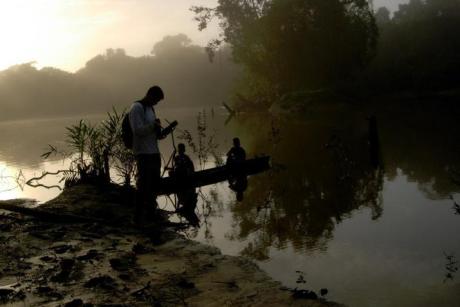The Duke Global Health Institute, in conjunction with Duke’s Center for Comparative Biology of Vulnerable Populations, has awarded three pilot project grants to stimulate interdisciplinary research in the field of global environmental health.
The three Duke projects will receive up to $50,000 over two years to explore a diverse set of issues affecting human health, ranging from the effects of water quality and toxin exposure to climate change. Further, the winning projects will focus on environmental and health issues in Ethiopia, the Brazilian Amazon, Peru and Bolivia.
“These projects were selected based on their interdisciplinary, scientific merit and potential for enabling investigators to leverage preliminary findings to obtain larger awards of external funding,” said Randall Kramer, Faculty Leader of DGHI’s Signature Research Initiative (SRI) in global environmental health. “Each of the projects holds promise to contribute to the SRI goal of expanding our understanding of environmental determinants of disease around the world.”
Faculty members involved in these projects specialize in a variety of areas, including biology, epidemiology, policy, economics, environmental engineering, biostatistics and parasitology. Two of the three projects also include faculty members from other universities, both locally as well as abroad where the research will be conducted. (See below for project descriptions and investigators.)
The Pilot Projects Program is an extension of DGHI’s global environmental health SRI, which encourages interdisciplinary research to tackle the complex biological, social, behavioral and economic aspects of global environmental health. The Center for for Comparative Biology of Vulnerable Populations supports research aimed at understanding how biological, physiological and social aspects of vulnerability alter the effect of the environment on human health.
Processes Controlling Groundwater Quality and Impacts on Human Health in the Main Ethiopian Rift
Principal Investigator: Peter G. McCornick, Director for Water, Nicholas Institute for Environmental Policy Solutions
Co-Principal Investigators: Avner Vengosh, Associate Professor, Division of Earth and Ocean Sciences, Nicholas School of the Environment; Tewodros Rango Godebo, Prospective Post-doc, Division of Earth and Ocean Sciences, Nicholas School of the Environment
Exposure to elevated levels of toxic and naturally occurring inorganic constituents in drinking water resources is one of the most important environmental issues that endanger human health. The Main Ethiopian Rift (MER) is an example of a large population regularly exposed to naturally occurring contaminants, such as arsenic and fluoride in drinking water. Through this project, researchers will investigate the mechanisms in which these toxic elements are mobilized into groundwater and the relationships between aquifer geology, water quality, and health of the local population. Understanding these processes is crucial to evaluate the human health risks and ecosystem effects of inorganic contaminants and, furthermore, for the development of rational and cost effective remediation strategies for contaminated groundwater. This project will also help to target safe groundwater drilling areas and identify aquifer layers that provide good quality groundwater, and would provide reliable information to policy makers for addressing the issues and effective water resources management of the Ethiopian Rift.
Modeling the Effect of Climate Change and Land Cover Change on Malaria Risk in the Brazilian Amazon
Principal Investigator: James S. Clark, Professor, Nicholas School and Department of Biology
Co-Principal Investigators: include Katia Koelle, Assistant Professor of Biology; Alex Pfaff, Associate Professor of Public Policy, Economics and Environment; Alan Gelfand, Chair of the Statistical Science Department, James B Duke Professor and Professor of Environmental Sciences and Policy; Marcelo Urbano Ferreira, Professor of Parasitology, Vice-Chair Department of Parasitology, Biomedical Institute, University of Sao Paulo; Monica da Silva Nunes, Associate Professor of Epidemiology, Federal University of Acre; Denis Valle, Duke PhD student, University Program in Ecology
Researchers will study how climate and land cover change together influence malaria risk in the Brazilian Amazon. Remote sensing tools will be used to assess how climate and land cover changes affect mosquito larvae habitat. Researchers will develop remote sensing and statistical modeling methodologies for strategic sites within the Brazilian Amazon with the long-term goal of extending this analysis to the entire Brazilian Amazon. Preliminary data will be collected to show the feasibility of extending our analysis to the entire region. These results will lead to a full proposal by this group to one or more federal agencies or foundations, addressing the potential hidden public health costs of climate change and environment / development policies.
A Tenacious Toxin: Mercury Contamination and Residential Exposure in Huancavelica, Peru and Potosí, Bolivia
Principal Investigator: Heileen Hsu-Kim, Assistant Professor, Department of Civil and Environmental Engineering, Duke University
Co-Principal Investigators: Nicholas Robins, Lecturer, Department of History, North Carolina State University; Susan Halabi, Associate Professor, School of Medicine, Department of Biostatistics and Bioinformatics; and Dan Richter, Professor, Nicholas School Division of Environmental Sciences and Policy.
This research will investigate mercury contamination within the cities of Huancavelica, Peru and Potosi, Bolivia and the potential exposure to residents. From 1564 to 1975, mercury was mined in Huancavelica and shipped to other Andean mining cities such as Potosí for use in silver refining. In each city, as least 25,000 tons of mercury were released into the environment, as indicated by archival research and substantiated by our initial survey demonstrating extremely high mercury levels in the soil. Moreover, scrapings from brick homes in Huancavelica contained up to 284 mg/kg, much greater than background levels for this region. Researchers will perform the first comprehensive analysis of mercury contamination in residential areas of these two cities, consisting of three phases: 1) Organize, with the help of local contacts, public meetings with residents in the most contaminated areas of each city to educate them on mercury exposure and potential risks; 2) Collect samples from the homes of volunteers (indoor dust, wall and foundation scrapings) and hair samples for mercury analysis; 3) Determine the spatial extent of soil mercury contamination and speciation in each city. The project involves a multidisciplinary research team from environmental engineering and science, ethnohistory, and biostatistics. The results of the work will form a critical building block for a larger public health initiative in the region.



